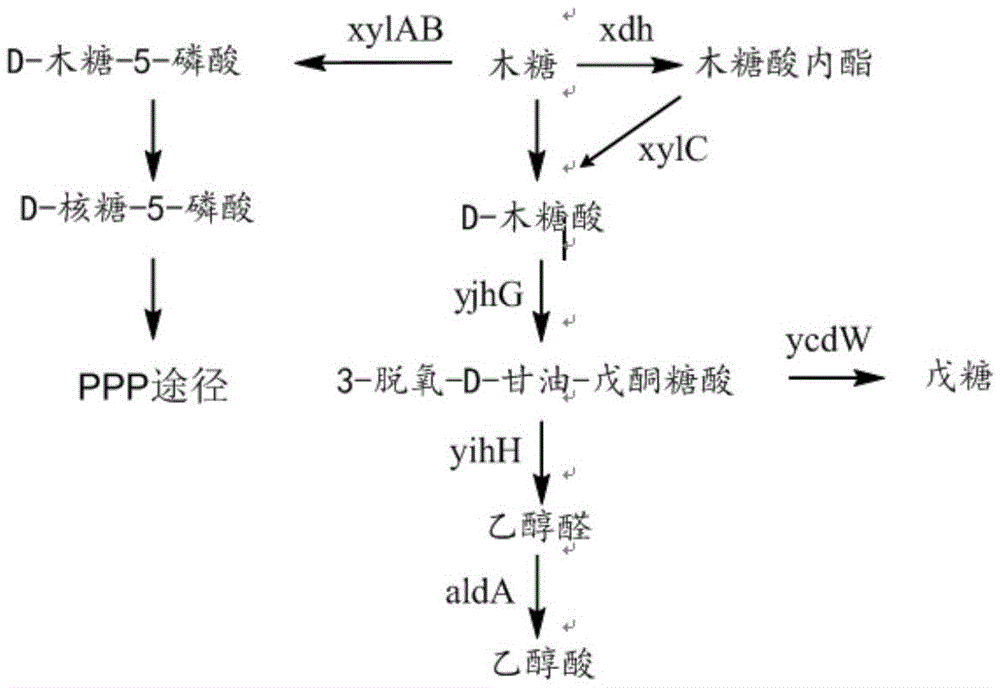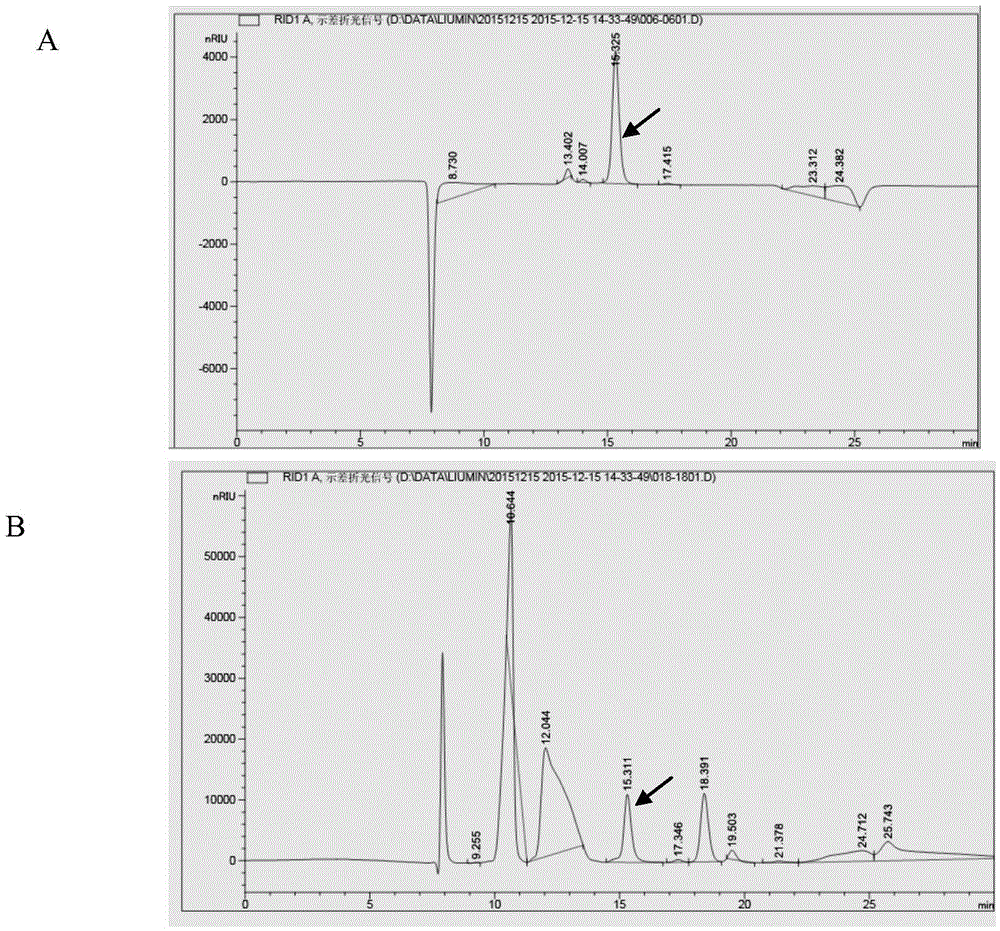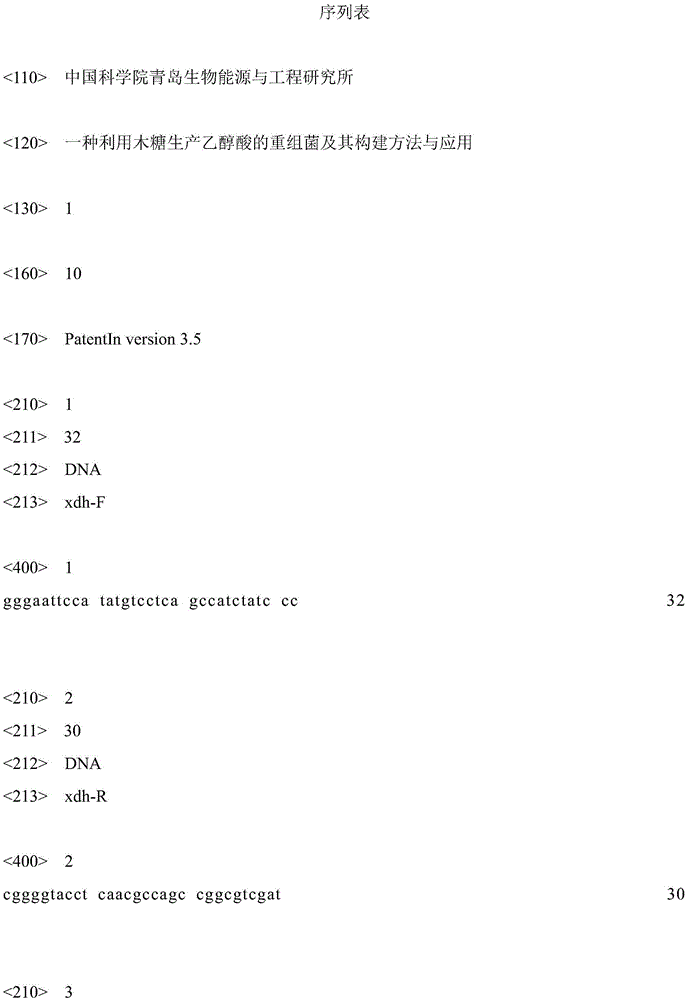Recombinant bacteria using xylose to produce glycollic acid and building method and application of recombinant bacteria
A technology of recombinant bacteria and glycolic acid, applied in the field of genetic engineering
- Summary
- Abstract
- Description
- Claims
- Application Information
AI Technical Summary
Problems solved by technology
Method used
Image
Examples
Embodiment 1
[0054] The cloning of embodiment 1 exogenous gene
[0055] Xylose dehydrogenase gene: (xdh) (GeneID: 7329904) was cloned using C. crescentus as a template and obtained by PCR amplification. The primer sequence was: xdh-F5'-GGGAATTCCATATGTCCTCAGCCATCTATCCC-3', xdh-R5'- CGGGGTACCTCAACGCCAGCCGGCGTCGAT-3'; Xylonolactonase gene (xylC) (GeneID: 7329903) was cloned using C. crescentus as a template and obtained by PCR amplification. The primer sequence is:
[0056] xylC-F5'-CCGGAATTCTAATACGACTCACTATAGGGGAATTG-3', xylC-R5'-AAGGAAAAAAGCGGCCGCTTAAACCAGACGAACTTCGTGCTG-3'; xylonate dehydratase gene (yjhG) (GeneID: 946829) was cloned using E.coli as a template and obtained by PCR amplification with primers The sequence is: yjhG-F5'-GGAATTCCATATGTCTGTTCGCAATATTTTGC-3', yjhG-R5'-CCGCTCGAGTCAGTTTTTTATTCATAAATCGCG-3'; 3-deoxy-D-glycerolpentulose aldolase gene (yjhH) (GeneID: 948825) was cloned from E .coli was used as a template and obtained by PCR amplification. The primer sequence was: yjhH...
Embodiment 2
[0057] The construction of embodiment 2 recombinant plasmids
[0058] 1. Construction process of recombinant plasmid pETDuet-1-yjhH-xdh-xylC
[0059] 1) The xylose dehydrogenase gene xdh cloned in Example 1 and the carrier pETDuet-1 were double-digested with NdeI and KpnI, and the target fragment xdh and the carrier pETDuet-1 after digestion were recovered with a recovery kit, and then ligated. The ligation product was transformed into E.coliDH5α, positive clones were screened, and the recombinant plasmid pETDuet-1-xdh was obtained;
[0060] 2) After the xylC gene cloned in Example 1 and the recombinant plasmid pETDuet-1-xdh were digested with EcoRI and NotI, the target fragment xylC and the vector pETDuet-1-xdh after digestion were recovered using a recovery kit, and then ligated. The product was transformed into E.coliDH5α, and positive clones were screened to obtain the recombinant plasmid pETDuet-1-xdh-xylC;
[0061] 3) After the cloned yjhH gene obtained in Example 1 an...
Embodiment 3
[0065] Example 3 Recombinant strain construction
[0066] Prepare the wild-type control strain E.coliBL21 (DE3) competent according to the operation steps of the TAKARA Competent Preparation Kit, and transform the recombinant plasmids pETDuet-1-yjhH-xdh-xylC and pACYCDuet-1-aldA-yjhG into Competent cells of the host strain E.coliBL21 (DE3) were used to obtain a recombinant strain, numbered ZG-2562.
PUM
 Login to View More
Login to View More Abstract
Description
Claims
Application Information
 Login to View More
Login to View More - R&D
- Intellectual Property
- Life Sciences
- Materials
- Tech Scout
- Unparalleled Data Quality
- Higher Quality Content
- 60% Fewer Hallucinations
Browse by: Latest US Patents, China's latest patents, Technical Efficacy Thesaurus, Application Domain, Technology Topic, Popular Technical Reports.
© 2025 PatSnap. All rights reserved.Legal|Privacy policy|Modern Slavery Act Transparency Statement|Sitemap|About US| Contact US: help@patsnap.com



